The Beaufort FCV Works Crew (1979-84)
A tribute to the Beaufort and other FCV works crews across Victoria
D Holmes
David was the Assistant District Forester at Beaufort from 1979 to 1984
The history of timber utilisation on Mt Cole and Mt Lonarch is already available on this site. (See: Mt Cole) I would like to add to this knowledge by recording who was on the Beaufort Forest Commission Victoria (FCV) District Works Crew in the period 1979-84, their skills, some of the work they carried out, and the legacy they left on both Mt Cole and Mt Lonarch.
As a Canadian trained forester I was new, in 1979, to the forests and wildfire conditions of Victoria. Over the following five years as Assistant District Forester I learned a lot from the Beaufort Crew, including respect for their knowledge and skills. I also enjoyed their humour and camaraderie. As their crew leader on many occasions, at large fires in East Gippsland and elsewhere, we lived, ate and worked together, and I came to know them quite well.
The Crew
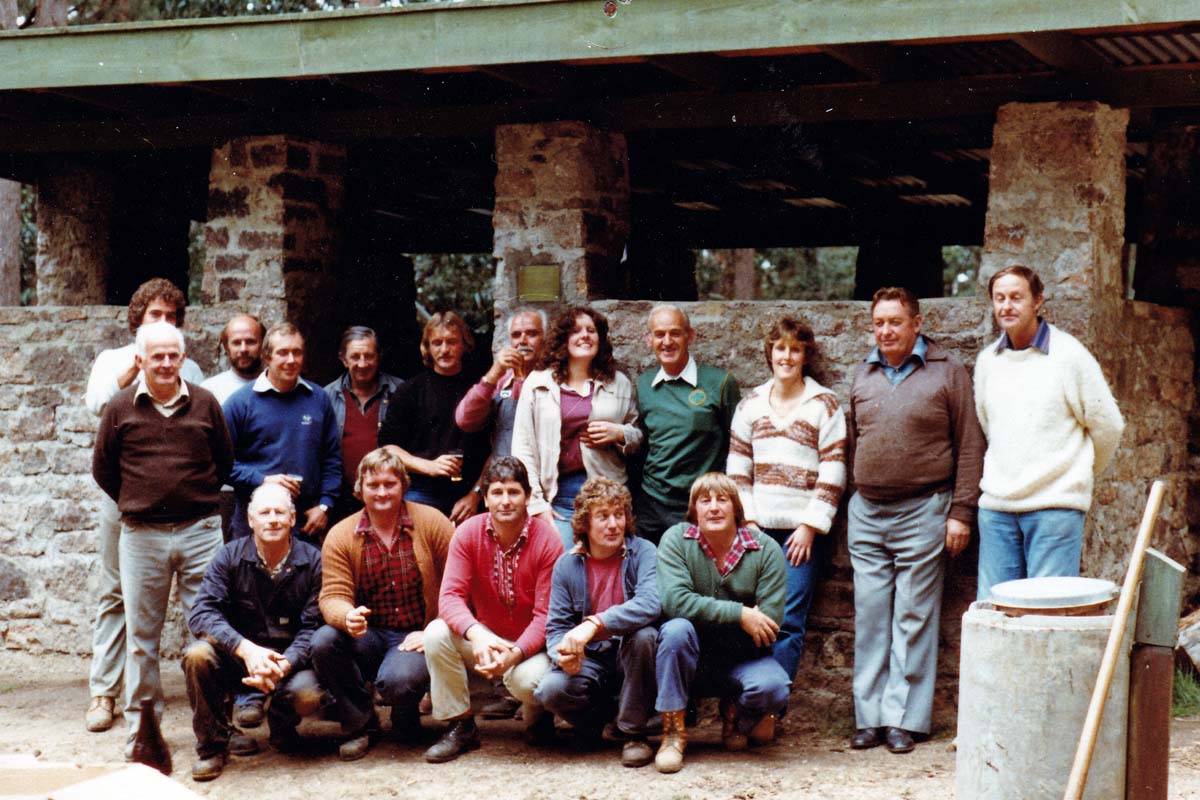
Beaufort Forest District - Staff and Crew
Nando Rosini's retirement function at Victoria Mill Scenic Reserve
Standing (l to r)- Gordon Angus (Forest Overseer),James O’Loughlan (behindAngus), Clark Dawson, Trevor Crowe, Bob Stevens, Ross Gillingham, Nando Rosini, Bronwyn Lyttle (Asst District Clerk), Frank Duke, Dianne Martin (District Clerk), Ron Murray (SW Division Fitter), Bob Allen (District Forester)
sitting (l to r) Archie Dickman, Kelvin Davies, Gary Morrison, James Hutchinson, Kevin Broadbent
1982
Photo: D Holmes
The stone hut in the background was built by Beaufort crew members Nando Rosini and Archie Dickman to replace the old wooden hut which had stood for a very long time. The brass plaque on the middle column was unveiled at Nando’s surprise retirement celebration. It names the stone hut ‘Nando’s Hut’ and commemorates his workmates esteem for him. Nando’s Hut is identified on many present day digital maps of Mt Cole and district.
Local knowledge, Experience and Skills
All of the Crew came from the local community (towns and farms). Many came from families that had resided in the area since European settlement. Their knowledge of local geography, roads, forests and fire behaviour in them was invaluable in first attack and suppression of local wildfires. They also knew their counterparts in the CFA and could work easily alongside CFA crews.
The regular Crew consisted of two main age groups – five in their late 50s and early sixties who had been on the Crew since sometime between WWII and 1960, and seven in their 30s. Just one member was in his early 20s at that time. However, the number in their 20s increased when the 8-10 man summer fire crew was employed.
All of the older men were highly skilled and experienced bushmen. Each had one or more specialty skills eg. bulldozer operation, grader operation, explosives, stone and concrete work, carpentry, storekeeping, seed extraction and storage.
The men in their 30s were all skilled and experienced bushmen and firefighters too. They could all drive tankers, operate chainsaws, fire pumps and other equipment. A number had specialty skills as well eg. tip-truck, front-end loader, tractor and slasher, grader and bulldozer operation. When the call came to send firefighters to other part of the State, the men selected always came from the younger group.
In the fire season the regular 12-13 man Crew was boosted with another 8-10 local men. Some of the fire season crew had experience from previous years, while others were new to it. Every year more young men from the local community gained fire fighting skills and experience in these fire season crews, and became valuable to the local community, FCV and CFA brigades.
There was a range of personalities but they would work together in effective teams, especially when fighting fires. They all had in common a love for working outdoors in the beautiful, tall forests of Mt Cole. There was camaraderie among them, respect for the older most skilled members, and willingness to help new younger men learn skills. There was also at times high spirits and laughter.
The Crew was undoubtedly similar to many other FCV crews around the State. Their practical forestry, firefighting and equipment operating skills were the backbone of the FCV’s ability to maintain forest roads, carry out silvicultural works and fuel reduction burns, establish and tend new softwood plantations, and fight wildfires. In the fire season they were the FCV’s frontline troops and equipment operators, who could be organised quickly into effective first attack units for local forest fires, or sent anywhere in the State to help with the containment and suppression of large wildfires on public land. At wildfires I often saw them work in extreme conditions, sometimes life-threatening, in unfamiliar territory, day and night, with discipline, courage and humour.
Two of the Crew's senior members were Nando Rosini and, his good friend and workmate, Archie Dickman.
Nando Rosini came to Australia after WWII from Slovenia, which borders present day northeast Italy. On arrival he was sent to work at the Warrak migrant forestry camp west of Mt Cole. Some years later he joined the Beaufort Crew. Nando was a broad-shouldered, strong, and good natured man, with European manners, who loved working on Mt Cole. He was also a very practical man with a sense of humour and a good stonemason. At lunch Nando would always plant his apple core wherever he was on Mt Cole, so that in the future there would be apples for people to eat. Over the years a number of apple trees grew and produced apples. Every person at Beaufort FCV held Nando in high esteem.
Archie Dickman was from a family that settled in the area in the 1800s. He had known Mt Cole since his childhood and knew from his family the changes that occurred to it since the arrival of Europeans. Archie was a WWII army veteran and one of the best allround bushman I have ever met. He could do almost anything – from driving a bulldozer to building a hut. He was also a champion axeman, winning two State wood chopping competitions. Archie also knew Mt Cole and its history better than anyone. He could find the old trenches dug to shelter men from wildfires, old pit saw sites from the 1800s, places where explosives were stored long ago, and where people picnicked back in the early 1900s (that were now overgrown). He was a treasure trove of local history. Archie was always willing to teach younger crew members skills and impart knowledge from his vast store. Every person at Beaufort FCV respected him.
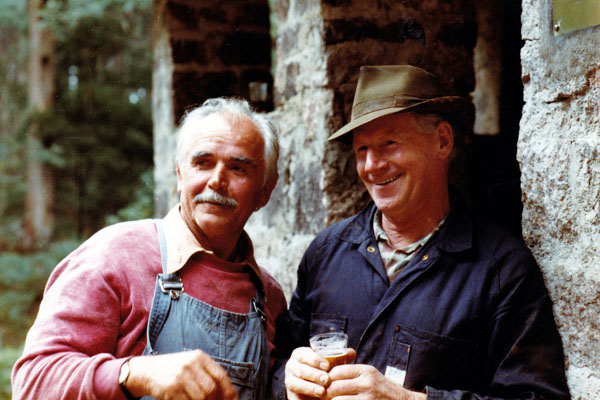
Nando Rosini's Retirement
Nando (l) with Archie Dickman
1982
Photo: D Holmes
1 In the same period the Forest Commission created the Forest Environment and Recreation Branch in Melbourne to support its multiple forest use policy, and developed the notion of a ‘recreation opportunity spectrum’ in State Forests, based on the USDA’s Forest Service.
2 This expansion continued on after the FCV was integrated into the Department of Conservation Forests and Lands in 1984.
The Regular Tasks
The work the Beaufort Crew did on a daily basis was organised by a Forest District works officer. The Crew started the work day at the depot where various tasks were assigned. There was a great variety of tasks, many of which were of a seasonal nature. They included road and track maintenance; recreation facility development and maintenance; seed collection, extraction, storage and sowing; pine plantation establishment and tending; fuel reduction burning; and regeneration burning. The following are some examples of Forest District works.
Road and Track Maintenance
The District had an extensive road and track network, but it was the network on Mt Cole and Mt Lonarch that required the most maintenance because of the terrain and higher rainfall. The networks here were extensively rebuilt/re-aligned and new ones built following WWII when the demand for timber led to the reopening of these areas for timber harvesting. Roads suitable for heavy log hauling vehicles were needed. Senior crew members Bob Stevens, Archie Dickman, Nando Rosini and Ron Murray had all been involved in building the post-war road network.
The road and track network needed the most maintenance late autumn through to late spring. A grader was shared between Beaufort and other Forest Districts in the South West Division. When the grader arrived Clarke Dawson, grader operator, and an offsider(s) were assigned to grading and cleaning out culverts and road gutters for weeks at a time. Operating a grader on winding mountainous roads was a highly skilled task.
During the winter and particularly following storms, the Crew members would systematically work their way through the road and track network cleaning culverts and gutters, removing fallen limbs and filling potholes. It was a major ongoing task from late autumn to late spring. Road maintenance was much easier in the 1970’s and 1980’s than it had been decades earlier. By then frontend loaders and tip trucks removed much of the heavy manual labour. Archie Dickman once described to me what it had been like. In the 1950’s a three man crew hand shovelled granite sand from a sandpit, into the box of 5 tonne truck and then two shovelled it off into the potholes while the third drove. They had a primitive grader towed by a truck.
Seed Collection, Extraction, Storage and Sowing
The Crew, and a crew from Ararat prison, would harvest ripe messmate capsules from felled trees using secateurs to cut capsule-bearing branchlets and then place them in hessian bags. These were taken to the Beaufort depot where the seed was extracted in a drying shed. Frank Duke would spread the branchlets on a open metal frame about 1.2 metres above the concrete floor, close the shed and turn on a powerful, temperature-regulated, heater. Over the next 2-3 days the capsules would begin to open. After this Frank would regularly turn over the branchlets, agitating them to encourage the seed to drop out of their capsules onto the concrete floor below. He would continue this process regularly until the capsules on the frame stopped dropping seed. Frank would then sweep up the seed and chaff, separate them, carefully store and label each batch with the date and location it was collected from, and arrange for a sample to be sent for viability testing.
In the autumn, following regeneration burning, the Crew would hand seed the coupes, distributing the seed on ash beds and bare mineral soil where the small seed had the best chance of producing seedlings that would survive the following summer. Seed from the nearest locality would be used, and the seed refrigerated for three weeks prior to break dormancy.
Forest Recreation
The cool glades of Mount Cole became favourite places for local people to picnic not long after European settlement. The growth of car ownership following WWII drew people from further afield. In the 1970’s local and Ballarat schools began showing interest in outdoor education opportunities on Mt Cole.1 Later in this decade, the Crew began upgrading and expanding the recreation facilities and opportunities on Mt Cole. These works continued on for many years.2
Richards Campground
In the early 1980s the District Forester, Bob Allen, learned of the existence of a picnic area before WWII in The Glut . Archie Dickman, who remembered being there when he was young, found it and the nearby cave which had been a popular spot to visit. The Crew then cleared the site, sowed it with grass and built picnic tables and fireplaces. A few years later they built one of the “Mt Cole Huts” on the site.”
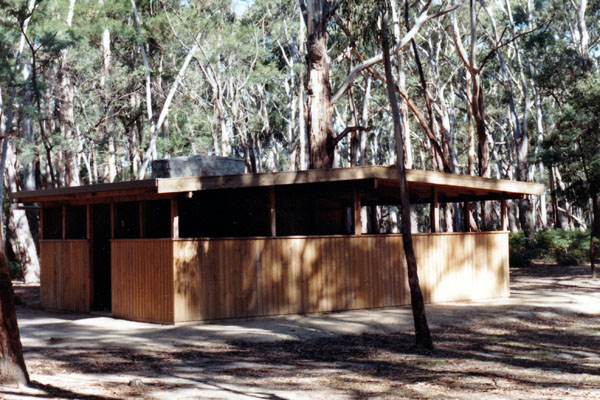
A 'Mt Cole Hut' at Middle Creek Campground
A solid wall faced the SW winds. Large openings under wide eaves let the light in and the rain out on the north, east and west facing walls. Entry on the east facing wall.
1983
Photo: D Holmes
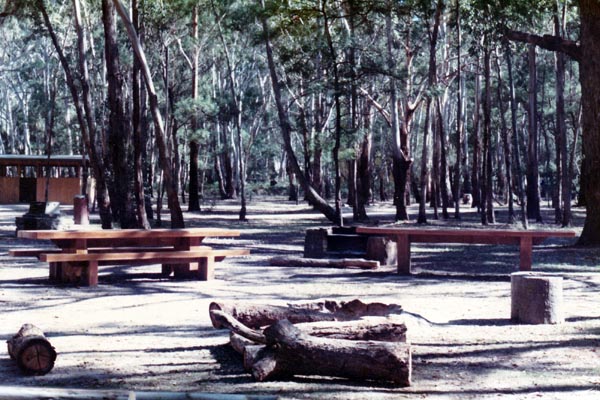
Picnic tables at Middle Creek Campground
Built by Archie Dickman
1983
Photo: D Holmes
Mount Cole Huts
The Crew built the first large modern hut, suitable for school and other larger groups, at Middle Creek Campground in the early 1980s. It was based on some drawings by me, with the final design, materials list and other specs made by Archie Dickman and myself. Archie then went on to lead its construction. Later this design was used to build huts at Chinamans and Richards Campgrounds. They are uniquely 'Mount Cole Huts'.
Picnic Tables
Archie Dickman was responsible for the design and construction of most of the picnic tables on Mt Cole and elsewhere in the Beaufort Forest District. Yellowbox trees yielded the tough durable wood that Archie and others would harvest and then cut the pieces out with a chainsaw. He and others would transport the heavy timber pieces to the site, assemble them on concrete or stone foundations and finish them. The balance of the tree was used for firewood at the campsites.
Fireplaces
Nando Rosini, a skilled concreter and stonemason, built most of the fireplaces on Mt Cole up until his retirement in 1982.
Walking Tracks
The early 1980s saw the commencement of a walking track construction program on Mt Cole for school groups and others to enjoy the beautiful landscapes, tall forests, ferny gullys and flora and fauna. Over a number of years the Crew built kilometre after kilometre of walking tracks laid out by me. The first new walking tracks included the track from Richards Campground to Ditchfield Camp; from the junction of Camp Link Rd and Mt Cole Rd to The Sugarloaf; from Middle Creek Campground to Bailes Campground and to Ferntree Tree Picnic Area; the walking tracks on the southwest facing slopes of Cave Hill and The Sugarloaf area in the State Park. Later, some of these walking tracks were incorporated into the Beeripmo walking track, which was a two day hike. The facilities that the National Parks Service now enjoy were nearly all built by the Beaufort FCV (and later CFL) Crew. It is one of their enduring legacies.
Site Maintenance
Frank Duke would service the recreation sites weekly and report firewood supplies. When the District stockpile was low, a firewood cutting crew would replenish it and the sites. Supplying the recreations sites with readily usable firewood reduced damage to the surrounding forest significantly.
Fire Suppression
The Beaufort Crew was often called to fight wildfires in other parts of the State. Here they met other FCV District crews with whom they had fought fires in previous years. After their shifts there was often a lot of catching up with a real sense of camaraderie. In 1981 the Crew were at the Big Desert and Cann River wildfires. In 1983 it was part of the FCV resource at the Greendale fire at Daylesford, Ash Wednesday fire at Trentham, Cann River Fire #12 and Cann River Fire #16. The fire behaviour that year was extraordinary at times and dangerous. Everyone was wary since the tragic death of two FCV staff, Alan Lynch and Des Collins, at the Greendale Fire on 8/1/1983. The Cann River fires were very large fires that required significant FCV resources and weeks to contain and suppress them. (See: The 1982/83 Fire Season)
The Beaufort Crew had many firefighting experiences, mostly in East Gippsland. Descriptions of a few of these experiences follow.
Call-up to go to Cann River or Orbost usually came in the morning while Crew members were on Mt Cole. Those selected to go would come down off the Mount and go home, pack, say goodbye to their family and meet at the depot where Frank, the storekeeper, had assembled vehicles, equipment, sleeping bags and other gear to take. The fire crew usually left sometime after lunch, drove 7 or 8 hours to Orbost or Cann River, and arrived at their destination sometime in the evening. What happened after that varied with the circumstances. Sometimes they were rostered to take over from night shift crews next morning, and at other times they were rostered to work on the coming night shift. If it was the former the Forest District’s fire logistics team arranged eating, sleeping and the next day’s briefing. If it was the latter the logistics team arranged food, storage of personal gear, equipment and a local guide to the fireline.
Night shift and Backburning. It was usually dark when the Crew was guided to the fireline to assist with a backburning operation. A local crew, familiar with the area and local fire behaviour, always did the drip torch and initial control work on the control line. Visiting crews would be assigned sections to patrol behind the local crew and put out any escapes. Occasionally they would dampen down a fiery bit inside the control line to prevent it escaping, but it was important to let it all the fuel next to the line to burn out. Nightshift was usually pretty spectacular with the backburn quite active within 50 or so metres of the line being patrolled. The flames and sparks contrasted vividly with the darkness. Hollow trees on fire within would act like chimney’s spewing forth columns of flames and glowing sparks in the darkness and eventually collapse with a big crash and burst of flames and sparks. Adrenaline kept the Crew going during the night but by dawn they were very tired. They had been on the go for 24 hours. On the way out they would see the landscape they had driven through in the darkness the night before. A shower, big breakfast and crawling into a sleeping bag were most welcome.
Cann River. The small town of Cann River was a welcoming town for visiting FCV crews. The District Forester, Dennis Read, was a master of logistics in dealing with the large influx of FCV crews from around the State as well as fighting wildfires. Volunteers fed us and residents of the town would greet us on the street and ask us where we were from. In the evenings the pub was a meeting place for rostered-off crews to catch up with one another for a brief time and talk to local residents, before their crew leaders came to say – sorry mate but it’s time to leave and get some sleep so we’re fit for tomorrow’s work.
Orbost District - An Escape. One day, the Crew had a radio call that the fire had jumped the control line of the section we were patrolling. We arrived shortly to see a breakout of about a hectare and a lone bulldozer operator trying to control the front of the breakout by attacking it from behind. He was driving back and forth between the trees in rapid motions, knocking down the burning shrub and small tree layer and smothering it with soil – with the intent of taking out the heat and flame causing the crown fires above. On his forward thrusts the flames were above him and all around his machine. The Crew immediately sent its small tanker into the breakout to put water on the dozer in an arc so it would land on top of the dozer and flames around it, while keeping well back as the driver was focussed entirely on stopping the fire, and his vision was impaired by the smoke. The dozer driver succeeded in stopping the front of the breakout while the rest of the Crew blacked out the other edges.. We received a call from the District control centre asking if we needed firebomber support, but were able to say we getting on top of it and wouldn’t need it. When the breakout was controlled the dozer driver came over to thank us for the tanker support. His eyebrows and hair below his safety hat were all singed, and his face bright red from the heat and undoubtedly minor burns. He was an Orbost local and his courage undoubtedly saved the day. We would have been unable to contain it with the equipment we had.
Cann River 1983 - The Minister for Forests. One evening after our shift, when we were tired, dirty, hungry and eating the evening meal that volunteers had prepared, a well-dressed man came and sat down with us. He introduced himself as Rod Mackenzie, the Minister for Forests, and then proceeded to ask us where we were from, what jobs we were doing on the fireline and what it was like. We all appreciated the interest shown and his personable approach. After wishing us well he left and went to another table where another tired, dirty and hungry crew were eating their evening meal.
1983 - An Awesome Sight. The Crew was went to a fire near Bonang and then to Cann River (fire #16) via Bombala. When we arrived in Bombala it was dusk and most of the town’s residents seemed to be on the main street looking south. We stopped too to see what they were looking at. We then had a view, unobscured by the forest we had been travelling through, of a huge front of boiling smoke punching through the atmosphere and gradually easing kilometres high in a massive thunderhead formation, with the setting sun from the west and flames below making the smoke clouds glow red and orange against the blue evening sky. It was an awesome sight.
Cann River 1983 - Courage. The fire weather was extreme several days later. Rob Youl, our sector boss, came to us looking for volunteers to drive into a property in unburnt country and check if the residents had evacuated. Kelvin Davies and Rob Miller volunteered knowing they could potentially be trapped by an advancing front. They returned about an hour later with a scorched Toyota, paint peeling off the vehicle ID sign, and red faces. It had obviously been a hot and dangerous mission.
Genoa March 1983. Later that day we were sent to the little town of Genoa. The fire had broken the control lines and was having a strong easterly run. During the next few hours at Genoa we witnessed the aggregation of a huge armada of firefighting equipment and firefighters. The little town was abuzz with tractors and dozers clearing vegetation and anything flammable from around every building. A tent town grew all around the little hotel. All eyes looked west to another huge fire front heading towards us – and another cloud formation similar to the one seen earlier in Bombala. When we went to bed we were expecting to be woken later that night to begin the town’s defence. However, when we looked west in the morning the fire front was still kilometres west of us. The fire front had hit fuel reduction burns in a strategic fuel reduction corridor and night crews had put in a heroic effort to contain and back burn the gaps. That day the Beaufort and other crews worked on the fire edge again and the following day the Beaufort fire crew was rostered off and sent home.
Cann River 1983 - Blacking Out - Blacking out is the last stage of fire suppression. It is the task of making the fire edge safe from the spread of burning embers into the adjacent unburnt forest in the next hot spell. In regrowth and mature forest without many scars or hollows it can be done without a dozer and attached tree-pusher. The newly burnt area is fresh with soot, ash and a strong smell. There is usually residual heat in the ground too. Particular care is required to make sure there are no hot spots or smouldering embers in burnt out stumps, log hollows or tree hollows left within an average tree height or about 30-40 metres of the control line. The Crew methodically and carefully blacked out kilometre after kilometre at Cann River Fire #12. The Crew was split in two. One section would walk parallel to the control line, with a rakehoe, spread apart every 5-7 metres back into the forest for 30-40 metres, checking for hot spots with the back of their hand and wisps of smoke, while a tanker crew drove in parallel with them. When a burnt out stump hole was found the crew member would grub out the ashes and feel for heat with the back of his hand. If it was hot or embers were found he would signal the tanker crew, who then would drag out the fire hose and assist by wetting it down thoroughly until it was cold. The rest of the crew would assist if it was a big job or keep looking if it was a small one. When a log with a hot smouldering hollow was found the tanker crew would be signalled to drag out the fire hose and bring a chainsaw. The log was cut open and hosed down until it was cold. If it was tree with a smouldering scar the tanker crew would be signalled, the fire hose dragged out and the embers wetted down thoroughly. Occasionally a tree needed to be felled to extinguish a large smouldering hollow, but not often. Felling a tree with a large smouldering hollow is particularly dangerous. Blacking out was an important task, but it was a long, hot, sweaty and dirty one. Occasionally spontaneous humour and camaraderie broke out to lighten the work. The end of the shift, a shower, hot meal, and a couple of pots were most welcome before crawling into sleeping bags.
Life-threatening Experiences. I know for certain that some men in the Crew, and in other FCV crews, had at some time in their past experienced close encounters with the flames, intense radiant heat and smoke of a wildfire for a period of time that was long enough to be life-threatening. Nearly all will never talk about them, myself included. They don’t want to remember them or their family to know about them.
The Families. Every time the Crew was sent away, their families were impacted as well. The support of husbands and fathers was absent. In 1983, their wives and children all knew of the earlier tragic deaths at Daylesford. They were all dreadfully concerned for their husbands’ welfare when they were away fighting fires. The responsibility of returning them to their safely to their families weighed heavily on me that year.
Their Legacy
The legacies of this Beaufort FCV Crew, and all the other local men who had been in it at one time or another, remain with us to the present day - in the road networks, the tall messmate regrowth stands, the walking tracks, huts, picnic tables and fireplaces they built on Mount Cole and elsewhere in the Forest District. Other FCV crews left similar legacies throughout the forests of Victoria, regardless of which State government agency now manages them.
"The Wake" for the end of the FCV
The FCV ceased to exist in 1984. Beaufort Forest District personnel were absorbed into the new Department of Conservation, Forests and Lands, but for more than a year Beaufort personnel continued to function as before, until the new Department settled on a structure and started filling positions. Robert ‘Bob’ Allen was Beaufort’s last District Forester. Robert ‘Rob’ Jolly was Beaufort’s last Assistant District Forester. The rest of Beaufort’s personnel were absorbed ‘in situ’ into the new Department’s structure.
The photos below include then current and retired personnel.
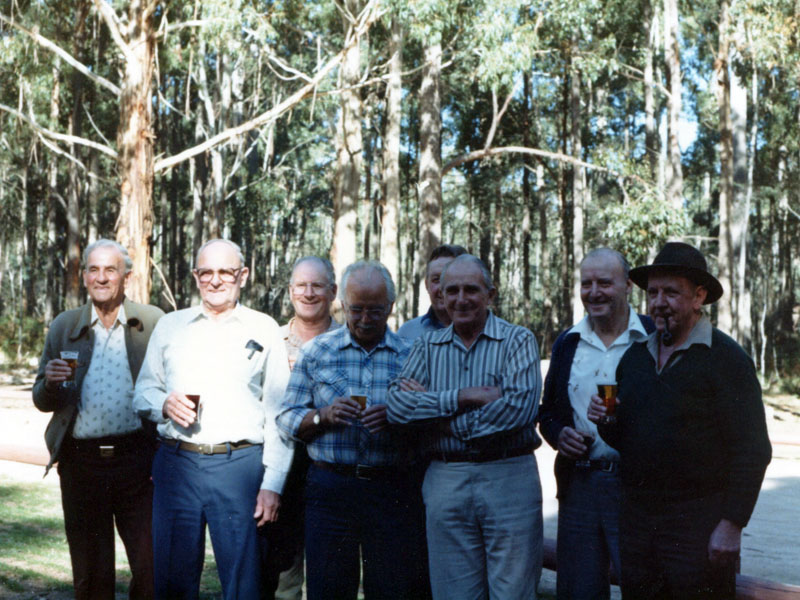
"Wake" for the FCV
l to r - Joe Lamb, Hec McConachie, Archie Dickman, Nando Rosini, Ron Murray, Carl Gustus, Merle Pearce, Dennis O'Connor
Summer - 1984/85
Photo: D Holmes
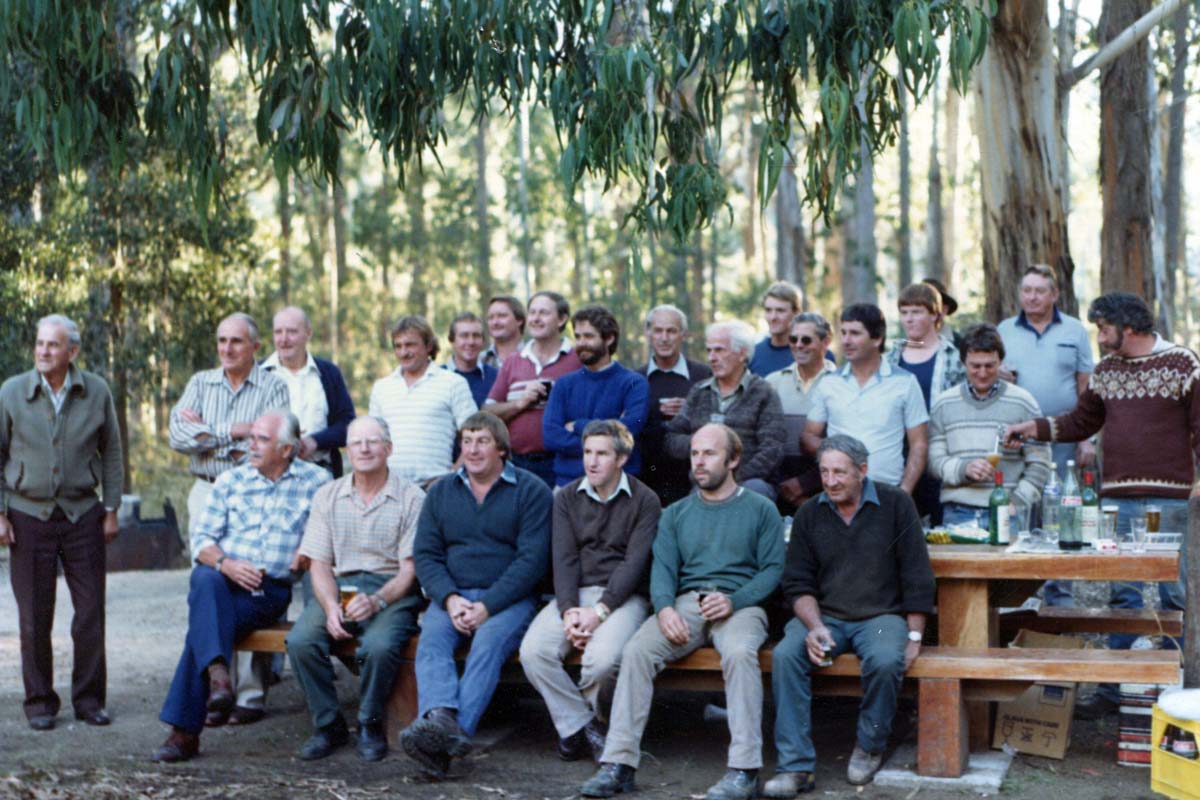
"Wake" for the FCV
Standing (l to r) - Joe Lamb, Carl Gustus, Merle Pearce, Ross Gillingham, Trevor Crowe, Kelvin Davies, Bob Allen, Rob Jolly, Frank Duke, Gordon Angus, Angus McKinnon, Tim Robinson, Gary Morrison, Ken Dickman,James Hutchinson, Ron Murray, Gary Christian
Sitting (l to r) - Nando Rosini, Archie Dickman, Kevin Broadbent, Bill Top, Clark Dawson, Bob Stevens
Summer - 1984/85
Photo: D Holmes
Assistance
I would especially like to thank Kathie Pitt, Elizabeth Thurgood from the Beaufort Historical Society, Bronwyn Lyttle, Kelvin Davies, FCV Crew member and Beaufort Forest Works Officer 1997-2012 (NRE, DSE) and Helen, his wife, for assisting with the text.
Acknowledgements
The author acknowledges the Beeripmo Balug clan of the Djab Wurung First Nations people, who occupied the area around the Mount Cole Ranges for some 50-60000 years. Beeripmo means ‘wild mount’, which is believed to refer to Mount Cole. In addition the author acknowledges the clan’s management of Mount Cole and its surrounding lands. They created, with their knowledgeable use of fire, the park-like landscape the first Europeans saw, and the conditions where they could ride easily through the landscape and up to Mount Cole on horseback.
